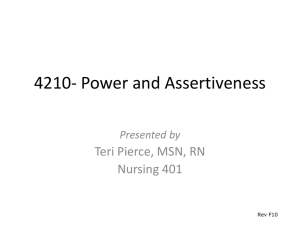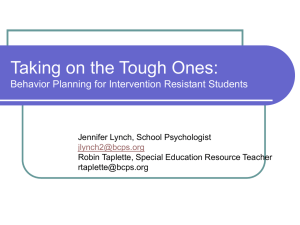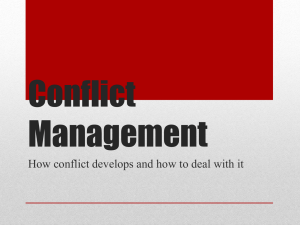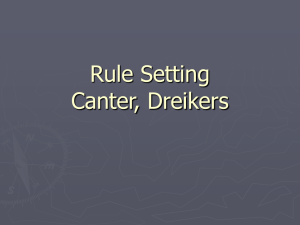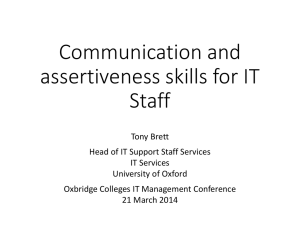Mod 4-C slides
advertisement
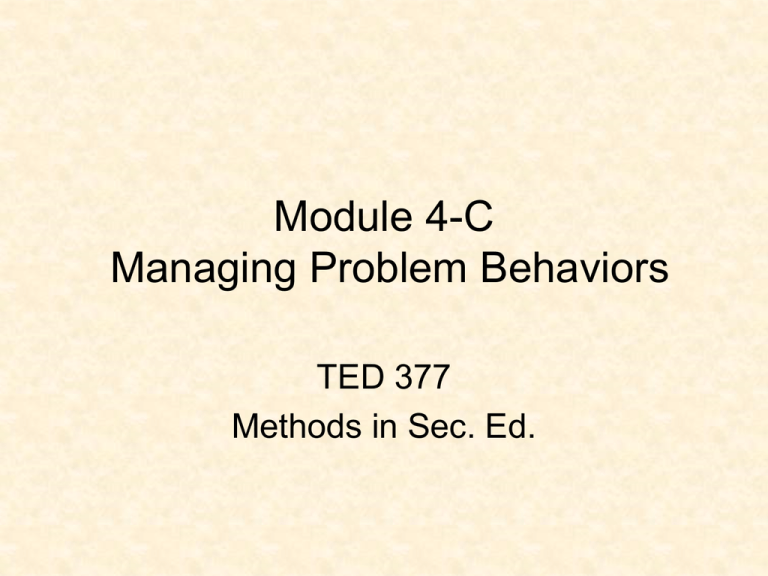
Module 4-C Managing Problem Behaviors TED 377 Methods in Sec. Ed. Module 4-C Students will explain types of motivation and behavior management problems presented by Secondary students, including integrated students with disabilities. • • • • • Levels of problem behavior. Interventions. Teacher-defiance problems. Things to remember. Assertiveness. Many Approaches to Classroom Management • Behavior Modification (Skinner) • Reality Therapy Model (Glasser) • Assertive Discipline model (Canter & Canter) • Logical Consequences approach (Dreikurs) • Cooperative Discipline (Albert) • Communications model (Ginott) Levels of Problem Behaviors Levels of Problem Behavior Major Problem, Spreading Major Problem, Contained Minor Problem Non-problem Introduction • What are levels of teacher intervention for disruptive behaviors? Classroom Behaviors Interventions (3:16) Levels of Problem Behavior • Non-problem: – “Common behavior” problems. – Brief, and do not interfere with instruction. – Examples: brief, minor talking, brief off-task activities. Teachers can ignore common behavior. To deal with every instance would be an interruption and a drain. Levels of Problem Behavior • Minor problem: – Go against classroom rules or procedures, but do not seriously interfere with learning. – Examples: calling out, leaving seats, passing notes, extended talking, eating candy, off-task activities. Do not let this behavior “slip” by. It could spread, affect learning, and undermine your classroom management system. Levels of Problem Behavior • Major problem, contained: – Disrupt activities and interfere with learning. – Limited to one or a few students. – Examples: refusing to do work, breaking classroom rules, chronically off-task, walking around room and talking. Levels of Problem Behavior • Major problem, spreading: – Any problem behavior that is commonplace and that is a threat to order in the classroom. – Examples: students roaming around the room, students talking back and refusing to comply with teacher’s requests. Interventions (minor, moderate, and more extensive) Minor Interventions • • • • • • Use non-verbal cues. Increase the pace of the activity. Use teacher presence. Redirect behavior. (“Everyone should be…”) Tell students to stop the behavior. Frame a choice: comply or consequence. (“You may choose X; if you continue, you will be choosing Y.”) • Use an “I-Message.” (“When you do X, it causes Y, and I feel Z.”) Moderate Interventions • Withhold a privilege or desired activity, with ability to earn it back. • Isolate or remove students. • Impose a fine/penalty. (extra assignment) • Give student detention. – Most students want to avoid this. – Limits extra attention to the situation. – Allows teacher to conference with student. • Refer student to assistant principal. More Extensive Interventions • Use an individual contract with student. – Discuss problem with student. Ask “why?” – Identify possible solutions. – Agree on a course of action. – Specify: • Expected change in behavior. • Consequences. • Maybe include an incentive. More Extensive Interventions • Conference with a parent/guardian. – Tell parent you would appreciate support in helping understand and resolve the problem. – Don’t make parent feel defensive/responsible. – Determine if phone or in-person meeting is warranted. Based your decision on knowing student and parent: • Some parents overreact. • Some parents are defensive. More Extensive Interventions • Reality Therapy Model (William Glasser) 1. Demonstrate caring, personal interest. 2. Conference with student. – “What happened?” “What is going on?” 3. Help student accept responsibility. 4. Help student evaluate behavior. – “How did behavior help/hurt you/others?” 5. Develop a plan/contract. 6. Have student commit to the plan/contract. 7. Monitor and follow through. Teacher Defiance Problems Rudeness Remind student of class rules (“be polite” or “respect others”). Tell student he/she must find a more acceptable way to express feelings. Conference with the student if behavior continues. Realize that a student may seem rude, but may not intend to do so. Remember peer pressure. Adolescents would rather appear “bad” than “dumb.” Refusal to Do Work Ensure students realize impact on grades. Contact parent/guardian to help you understand and to provide support. Get help from extracurricular teachers/coaches (if applies). Check student work early in year to catch this problem early. Defiance or Hostility Avoid a power struggle. Do not engage in confrontation with student. Allow student to cool down. Redirect student back to the learning activity. Deal with student privately later. If extreme, call the office. Things to Remember Remember • Try to handle things “locally” (in the classroom) rather than involving the office. • Try not to let classroom management be your job; your job is teaching/learning. vs. Remember • Start off nonverbally: – Nonverbal: Make eye contact, use a signal, use your physical presence. – Verbal: Remind student of correct procedure, redirect student attention to the task, ask/tell student to stop behavior, use facial expression and tone. – Private talk: Conference with student. – Contract: Have student commit to agreement. – Office: Put student on detention, contact viceprincipal. – Contact parent: Gain help and support. Remember • Be positive with students. • Maintain a positive climate/atmosphere. • Do not focus on negative behavior. Don’t let anything interfere with learning. • Don’t like the behavior, but don’t dislike the student. • After correcting a student, be welcoming and supportive. (Don’t hold a grudge!) Remember • Don’t take bad behavior personally. It may have nothing to do with you. • If someone is misbehaving, it is for a reason. Try to determine the reason. – It could be with the student (problem at home, some type of pressure). – It could be with the teacher (plan better lessons, increase the pace, be proactive in classroom management). Assertiveness Assertive Discipline (Canter & Canter) 1. Teachers have professional rights and should expect appropriate student behavior. 2. Students have rights to choose how to behave; teachers should plan limits for inappropriate behavior. 3. Clearly and firmly state expectations and explain boundaries. 4. Establish positive (good behavior) and negative consequences (inappropriate behavior). Characteristics of Assertive Teachers • According to the Canters, assertive teachers: – Do not allow any student stop them from teaching for any reason. – Do not allow any student to stop another student from learning for any reason. – Do not permit behavior that is not in students’ best interests and/or not in the best interests of others. – Routinely recognize, support, and reward appropriate behavior. Class Activity • Developing Assertiveness Skills – Role-play (or talk through) the below-listed scenarios. • • Use appropriate body language, facial expressions, vocal tone. Insist that your rights be respected. – Discuss/debrief: • • Students: How assertive does the teacher seem? Teacher: – How assertive are you? – How does it feel? – How can you improve? Activity 1. A student was supposed to put equipment away, but has left it out in the classroom. The student is heading for the door, expecting the end-of-period bell. 2. During a class discussion, 2 students trade notes and laugh. You become aware that other students are beginning to pay attention to their activity, and you are beginning to get annoyed. Activity 3. A student has been off-task, not working on the guided practice you have assigned. You caught the student’s eye, but the student looked away and proceeded to talk to other students. As you move around the room, the student begins to make a paper airplane. Activity 4. As you begin class, one student starts to chew a snack (in violation of a class rule). When the student realizes that you have noticed, he/she stuffs the snack in his/her mouth, and proceeds to gets another snack out of the plastic. Activity 5. You were absent yesterday. Your third period class gave the substitute teacher a hard time. He left a copy of the note he sent to the principal describing the following behaviors: many students refused to work, several left for the lav and never returned, and a spitball fight took place. As the bell rings, you enter the room to start class.
